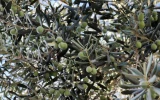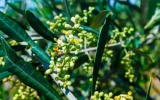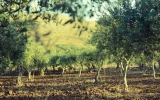Common Olive Tree Problems: 9 Diseases With Pictures
Fungal and bacterial diseases pose significant threats to olive trees, drastically reducing olive yield by 20-30% in afflicted regions like Italy, and leading to substantial economic losses in the olive oil industry. This article will help you identify nine of the most common problems of olive trees, highlighting each condition through pictures.
Common olive tree diseases include Peacock Spot, Olive Knot, Verticillium Wilt, Anthracnose, Root Rot, Bacterial Leaf Scorch, Canker, Olive Moth infestation, and Scale insect attack. These diseases and pests impact tree health and productivity, necessitating integrated management for effective control.
Each pest attacks in its unique way, threatening not just the tree's health but also the olive yields we cherish in our kitchens. Let's find out what measures you can take to outsmart these pests and diseases.
Summary
- Peacock spot is a fungal disease identified by dark, circular spots on olive leaves, potentially surrounded by a yellow halo, mainly spreading during wet conditions, which facilitate the movement of spores to infect other parts of the tree.
- Pseudomonas savastanoi, also known as olive knot disease, is characterized by bumpy growths or galls on branches, twigs, or trunks, which can constrict the tree parts, leading to girdling, reduced fruit production, and premature leaf drop.
- Verticillium wilt is a soilborne fungal disease that is particularly destructive, leading to yellowing, wilting, and browning of leaves, branch dieback, and potentially the death of the olive tree.

On this page:
- Common Olive Tree Pests and Diseases
- Peacock Spot Affects the Leaves' Elegance
- Olive Knot Distorts Branches and Twigs
- Verticillium Wilt Targets the Plant's Vitality
- Anthracnose Marks Fruits, Leaves, and Stems
- Root Rot Undermines the Plant's Foundation
- Bacterial Leaf Scorch Burns the Leaf Edges
- Canker Inflicts the Stems and Branches
- Olive Moth Endangers Flowers and Fruits
- Scale Insect Drains the Life From Stems and Leaves
Common Olive Tree Pests and Diseases
Growing olive trees can be a fulfilling endeavor, but you need to be aware of the common diseases that can affect your trees.
| Disease/Pest | Symptoms | Simple Combat Method |
|---|---|---|
| Peacock spot | Dark, circular spots on leaves | Use copper-based fungicides |
| Olive knot | Swellings on twigs and branches | Prune affected areas, apply copper compounds |
| Verticillium wilt | Yellowing and wilting of leaves | Remove affected plants, solarize soil |
| Anthracnose | Dark lesions on fruits, leaves, stems | Apply fungicides, prune for air flow |
| Root rot | Wilting, yellowing, decay at roots | Improve drainage, avoid overwatering |
| Bacterial leaf scorch | Browning of leaf margins | Remove affected trees, water and mulch |
| Canker | Sunken areas on stems, branches | Prune out infected areas, apply fungicides |
| Olive moth infestation | Larvae damage to flowers, leaves, fruits | Use pheromone traps, apply Bacillus thuringiensis |
| Scale insect attack | Scales on leaves, stems, causing yellowing | Apply horticultural oil or insecticidal soap |
Peacock Spot Affects the Leaves' Elegance
Peacock spot, also known as olive leaf spot, is a fungal disease that affects olive trees.The fungus responsible for this, Spilocaea oleaginea, creates dark, circular spots on the leaves of the tree.
These spots can be identified by their sooty blotches that may have a yellow halo around them.
How to identify peacock spot
- Initial appearance: Sooty blotches on leaves
- Spot characteristics: Black or dark brown, sometimes with a yellow halo
- Size: About 0.1 to 0.5 inch (2.5-12 mm) in diameter
Rain and water facilitate the spread of this fungus, as they allow spores to travel and infect other areas of the tree. You'll typically notice the spots more after periods of wet weather, especially if consistent moisture is present.
How to manage peacock spot
- Pruning: Regularly prune your trees to improve air circulation
- Water: Ensure proper drainage to avoid excess moisture
- Chemical treatments: Utilize fungicides with phosphorus acid to treat infections
To prevent peacock spots, try to focus on cultural practices like pruning and controlling moisture around your olive tree. In cases where the disease has taken hold, the use of fungicides becomes necessary.
Olive Knot Distorts Branches and Twigs
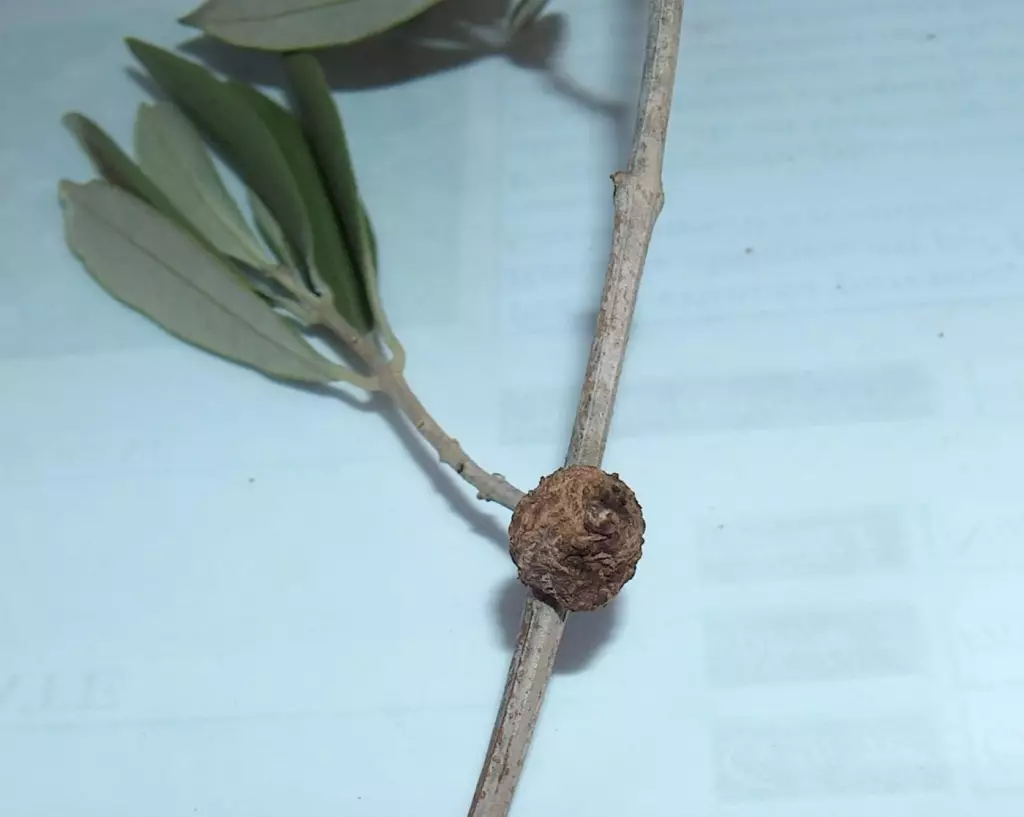
Olive knot is a common disease that can affect your olive trees, characterized by bumpy growths.
This ailment is caused by the bacterium Pseudomonas savastanoi. When your trees are infected, these growths, or galls, can be spotted on branches, twigs, or even the trunk.
| Visible Symptoms | Possible Consequences |
|---|---|
| Swollen knots | Girdling of twigs |
| Rough galls | Reduced fruit production |
| Deformed branches | Premature leaf drop |
How to combat olive knot
To tackle Olive knot disease, you need to integrate good sanitation practices. This includes pruning infected branches and disinfecting tools to prevent the bacteria from spreading.
When pruning, make sure to remove each knot completely and destroy the cuttings.
Treating olive knots can sometimes require chemical interventions. Copper-based fungicides can be effective when applied properly to the wounds. However, always follow the label's instructions to avoid harming beneficial soil organisms.
Remember, preventive measures are your best bet. Ensure your trees are healthy to resist infection and keep an eye on any wounds that could be entry points for the bacteria.
Verticillium Wilt Targets the Plant's Vitality
Verticillium wilt is a soilborne fungus that poses a significant threat to your olive trees. It's caused by the pathogen Verticillium dahliae, which invades the tree through its roots.
Symptoms of Verticillium wilt to watch for
- Leaves: Yellowing, browning, wilting
- Branches: Dieback
- Overall tree health: Decline, potential death
How to prevent Verticillium wilt
To safeguard your trees, start with proper soil drainage, as this fungus thrives in wet conditions. Before planting, select a site free from previous infestation history.
Try to avoid planting in soil that's previously hosted susceptible crops like cotton or tomatoes. Unfortunately, once a tree is infected, fungicide treatments are often ineffective.
Your best course of action is to remove and destroy the infected tree to prevent the spread of verticillium wilt.
Keep your trees healthy with appropriate watering, fertilization, and pruning practices.
Monitor regularly for symptoms and take action immediately if you suspect an infestation.
Anthracnose Marks Fruits, Leaves, and Stems

Anthracnose is a significant fungal disease that affects olive trees, primarily targeting the fruit. The disease is caused by species of Colletotrichum fungi which thrive in wet, humid conditions.
When your olives are infected, you might notice dark, sunken spots on the fruit's skin.
Symptoms of anthracnose
- Black, sunken lesions on fruit
- Withered and mummified olives on the tree
- Infected fruit might fall before harvest
The impact on olive oil quality can be substantial because the fungus affects the fruit, leading to a potential reduction in both yield and the sensory qualities of the oil.
Timely fungicidal treatments are crucial, especially before rain events that can facilitate the spread of the fungus.
Management tips to prevent anthracnose
- Pruning: Regularly prune your trees to improve air circulation.
- Sanitation: Remove and destroy infected fruit to minimize fungal spread.
- Fungicides: Apply appropriate fungicides, especially during periods of fruit susceptibility.
Getting ahead of anthracnose ensures your olive harvest remains healthy and protects the integrity of your olive oil.
Keep an eye on the weather and your trees for any signs of the disease, especially during the critical times of fruit development.
Root Rot Undermines the Plant's Foundation
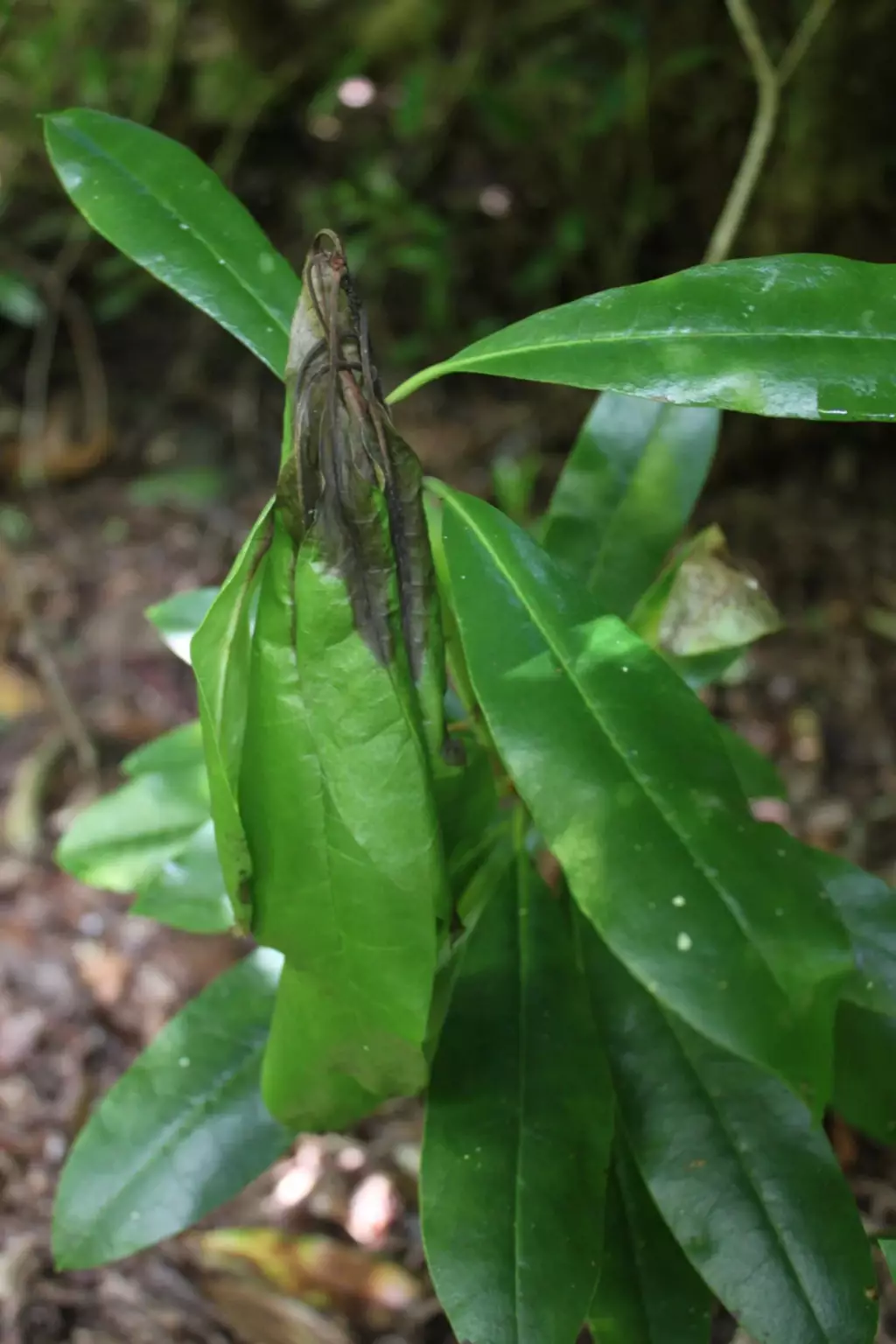
Root rot in olive trees is a serious concern that you should watch out for. It's commonly caused by certain fungi or waterborne pathogens like Phytophthora.
When these pathogens infect your tree's roots, especially in areas with poor soil drainage, the health of your olive tree can rapidly decline.
Root rot symptoms to look out for
- Wilting leaves
- Browning foliage
- Reduced growth and thinned canopy
- Dark, decayed root systems
How to manage root rot
Managing root rot involves careful attention to soil moisture and drainage. Here are some steps you can take:
- Ensure good drainage: Plant your olive trees in well-draining soil to prevent water accumulation around the roots.
- Avoid overwatering: Monitor soil moisture levels to prevent excessive water around the roots, which can create a breeding ground for fungi.
- Prune affected roots: If you detect root rot, prune the damaged roots to help prevent further infection and encourage healthy new growth.
Remember, consistent care and early detection are key in protecting your olive trees from the detrimental effects of root rot.
Bacterial Leaf Scorch Burns the Leaf Edges
Bacterial Leaf Scorch, often abbreviated as BLS, is a serious condition affecting olive trees, caused by the bacterium Xylella fastidiosa.
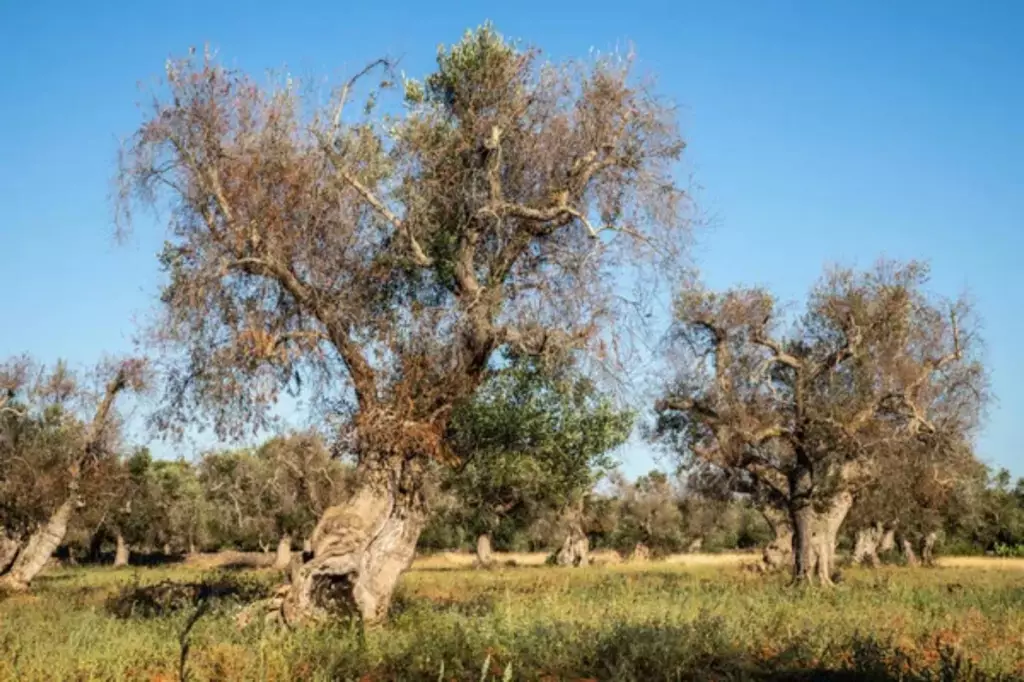
The disease is recognized by the scorching of the leaf margins, giving them a burned appearance. Note that this bacterium thrives in heat, which can exacerbate the spread and symptoms of the disease.
To effectively manage BLS, it's crucial to maintain proper water levels for your olive trees, as water stress can increase susceptibility.
There isn't a cure for BLS, but there are ways to prevent its spread. Regularly inspect your trees for signs of the disease, especially during the warmest months when the bacterium is most active.
Here's a quick checklist to minimize the risk of bacterial leaf scorch:
- Ensure trees get adequate water, especially during dry spells
- Avoid injuring the tree, as wounds can be entry points for bacteria
- Control insect vectors that can spread the disease
- Remove severely infected limbs to reduce the spread
Canker Inflicts the Stems and Branches
Canker is a term used for various fungal diseases that affect the bark of trees. When your olive trees are infected with canker, you might notice discolored and sunken areas on the branches, twigs, or trunks.
These lesions can crack and ooze, causing further damage to the tissue.
Symptoms of canker
- Sunken patches on bark
- Cracked or oozing areas
- Dead branches
Treating canker involves pruning and removing the infected branches. You need to sterilize your pruning tools before and after use to prevent the spread of the fungus.
Also, ensure good air circulation around your trees, as this can help reduce the risk of cankers. To promote good air circulation, it's best to follow specific spacing guidelines for olive trees.
How to treat canker
- Prune affected areas during dry weather
- Clean your tools thoroughly
- Improve airflow around trees
Regular inspection of your olive trees for early signs of canker can help you treat the disease before it spreads too extensively. Unfortunately, once the trunk is severely affected, it becomes difficult to save the tree.
Olive Moth Endangers Flowers and Fruits
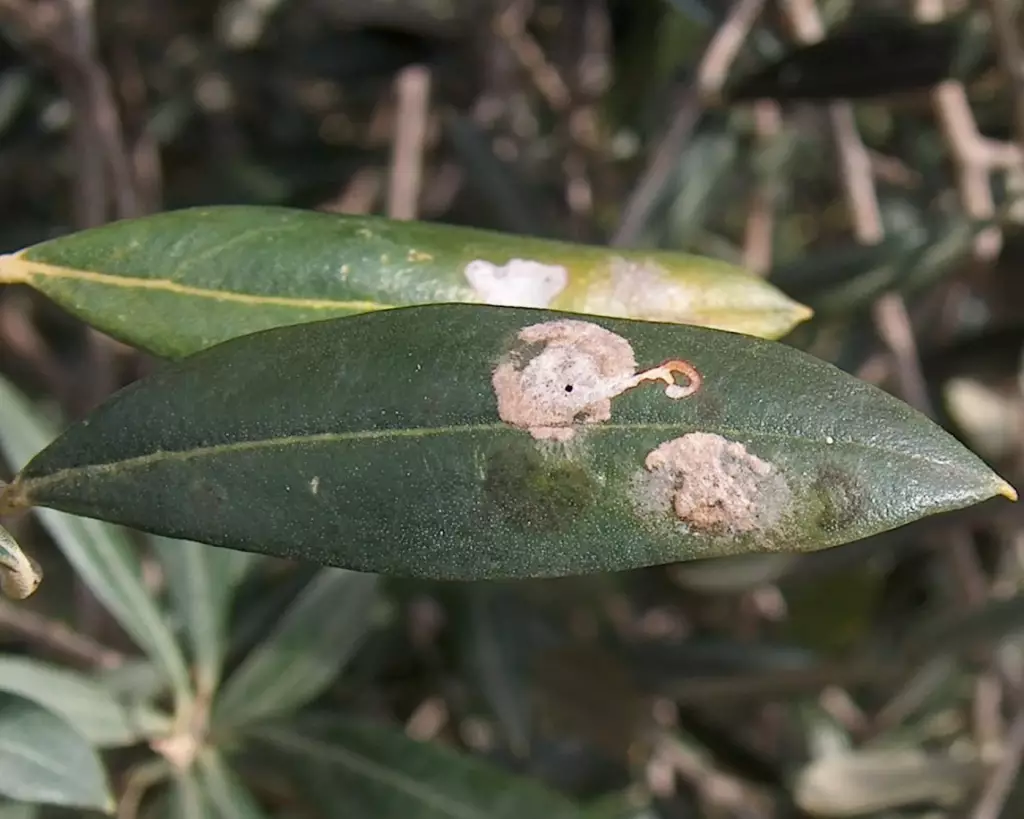
Olive moth (Prays oleae) is a significant pest that affects olive trees in various lifecycle stages- as phyllophagous larvae that feed on leaves, and carpophagous larvae that consume the fruit.
To treat these infestations, you may need to apply specific insecticides during key phases of the moth's lifecycle to prevent extensive damage.
Moreover, adopting preventive measures, such as timely pruning and removal of affected fruits, can deter moths from laying eggs.
Scale Insect Drains the Life From Stems and Leaves
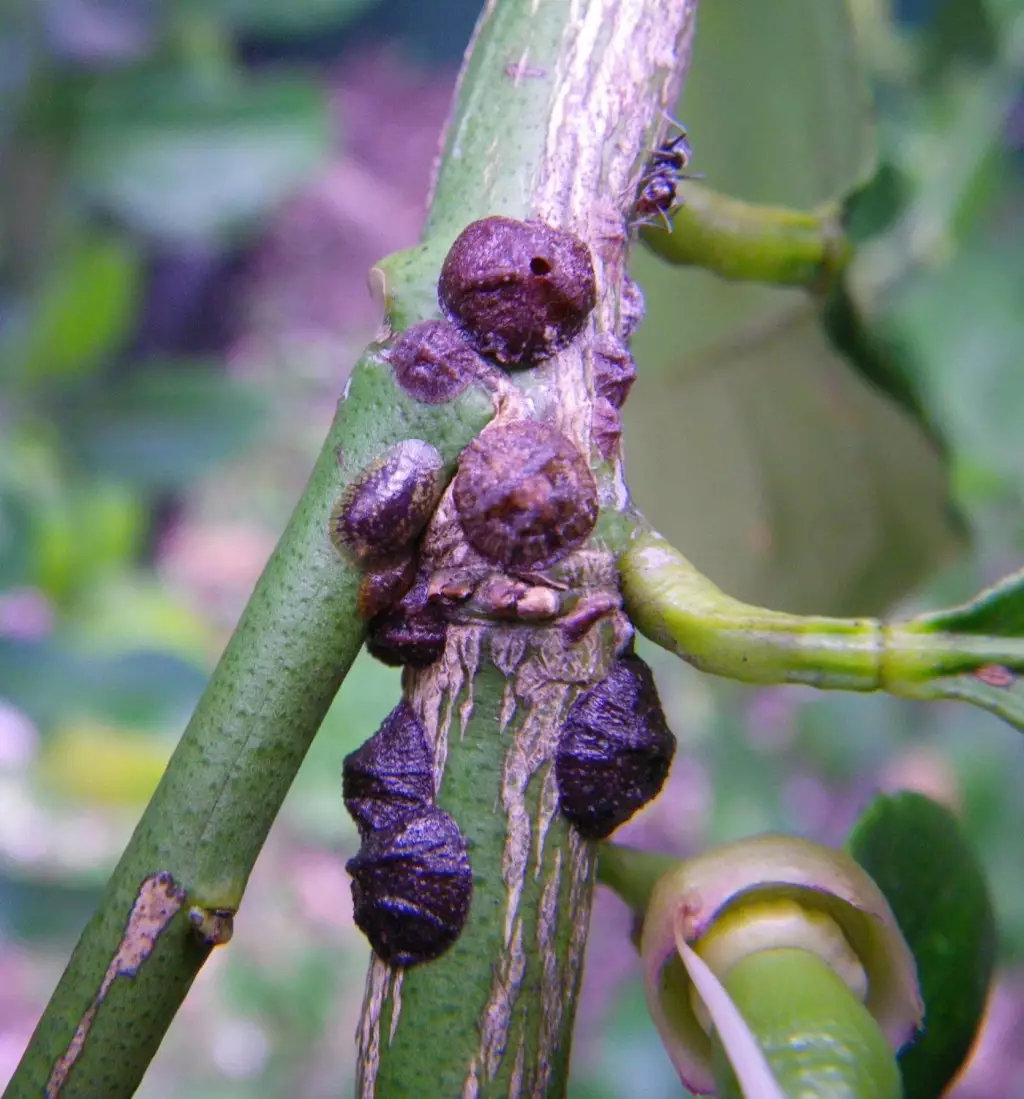
Scale insects like the black scale (Saissetia oleae) are sap-sucking pests that can weaken your olive trees.
The treatment for scale infestations includes using horticultural oils like neem oil. Neem oil can disrupt the pests' growth and reproduction.
Additionally, encouraging natural predators such as certain species of beetles, lacewings, and parasitic wasps can aid in controlling scale insect populations. Regular inspection is necessary for early detection and prevention.
